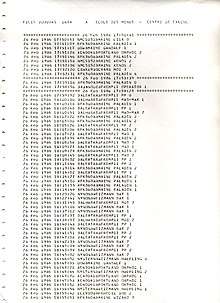BITNET
BITNET was a co-operative U.S. university computer network founded in 1981 by Ira Fuchs at the City University of New York (CUNY) and Greydon Freeman at Yale University.[1] The first network link was between CUNY and Yale.
The name BITNET originally meant "Because It's There Network", but it eventually came to mean "Because It's Time Network". [2]
A college or university wishing to join BITNET was required to lease a data circuit (phone line) from a site to an existing BITNET node, buy modems for each end of the data circuit, sending one to the connecting point site, and allow other institutions to connect to its site free of charge.
Technical details
Bitnet's NJE (Network Job Entry) network protocols, called RSCS, were used for the huge IBM internal network known as VNET. BITNET links originally ran at 9600 baud. The BITNET protocols were eventually ported to non-IBM mainframe operating systems, and became particularly widely implemented under VAX/VMS, in addition to DECnet.
BITNET featured email and LISTSERV software, but predated the World Wide Web, the common use of FTP, and Gopher. Gateways for the lists made them available on Usenet.[3] BITNET also supported interactive transmission of files and messages to other users. A gateway service called TRICKLE enabled users to request files from Internet FTP servers in 64 Kb UUencoded chunks. The Interchat Relay Network, popularly known as Bitnet Relay, was the network's instant messaging feature.
BITNET differed from the Internet in that it was a point-to-point "store and forward" network. That is, email messages and files were transmitted in their entirety from one server to the next until reaching their destination. From this perspective, BITNET was more like UUCPNET.
BITNET’s first electronic magazine, VM/COM, began as a University of Maine newsletter and circulated broadly in early 1984. Two email newsletters that began as Bitnet newsletters in the fall of 1987 are known to still be transmitting. They are the Electronic Air and SCUP Email News (formerly SCUP Bitnet News).
BITNET's eligibility requirements limited exchange with commercial entities, including IBM itself, which made technical assistance and bug fixes difficult. This became a particular problem when trying to communicate on heterogeneous networks with graphical workstation vendors such as Silicon Graphics.
Extent
At its zenith around 1991, BITNET extended to almost 500 organizations and 3,000 nodes, all educational institutions. It spanned North America (in Canada it was known as NetNorth), Europe (as EARN), Israel (as ISRAEARN),[4] India (VIDYANET)[5] and some Persian Gulf states (as GulfNet). BITNET was also very popular in other parts of the world, especially in South America, where about 200 nodes were implemented and heavily used in the late 1980s and early 1990s. Part of the South African inter-university academic network, initially known as UNINET, and later TENET (Tertiary Education Network) was implemented using BITNET protocols in the late 1980s, with a TCP/IP gateway to the Internet via Rhodes University.[6] With the rapid growth of TCP/IP systems and the Internet in the early 1990s, and the rapid abandonment of the base IBM mainframe platform for academic purposes, BITNET's popularity and use diminished quickly.
Legacy

BITNET hosted its first multi-user dungeon (MUD) in 1984, the text-based MAD.[7] Players connected from the United States, Europe or Israel to a single server running in France.
In 1996, CREN ended their support for BITNET. The individual nodes were free to keep their phone lines up as long as they wished, but as nodes dropped out, the network splintered into parts that were inaccessible from each other. As of 2007, BITNET has essentially ceased operation. However, a successor, BITNET II, which transmits information via the Internet using BITNET protocols, still has some users.
References
- "A Brief History of "Bit.net"". Bit.net. Retrieved August 30, 2012.
- Cailliau, Robert; Gillies, James (1 January 2000). How the Web Was Born: The Story of the World Wide Web. San Val, Incorporated. pp. 74, 75. ISBN 978-0-613-92163-3.
- Hura, Gurdeep (28 March 2001). Data and Computer Communications: Networking and Internetworking. CRC Press. p. 779. ISBN 9780849309281.
- "Humanist Archives Vol. 4 : 4.1144 Bitnet in Israel (1/69)". Dhhumanist.org. 1991-03-08. Retrieved 2017-03-07.
- "As emails turn 40, scientists recall India arrival | NDTV Gadgets360.com". Gadgets.ndtv.com. 2012-10-09. Retrieved 2017-03-07.
- Lawrie, Mike. "The History of the Internet in South Africa - How it began" (PDF). Retrieved 7 August 2012.
- Warf, Barney (2018). "BITNET". In Warf, Barney (ed.). The SAGE Encyclopedia of the Internet. SAGE Publications. pp. 56–57. ISBN 978-1-4739-2661-5.